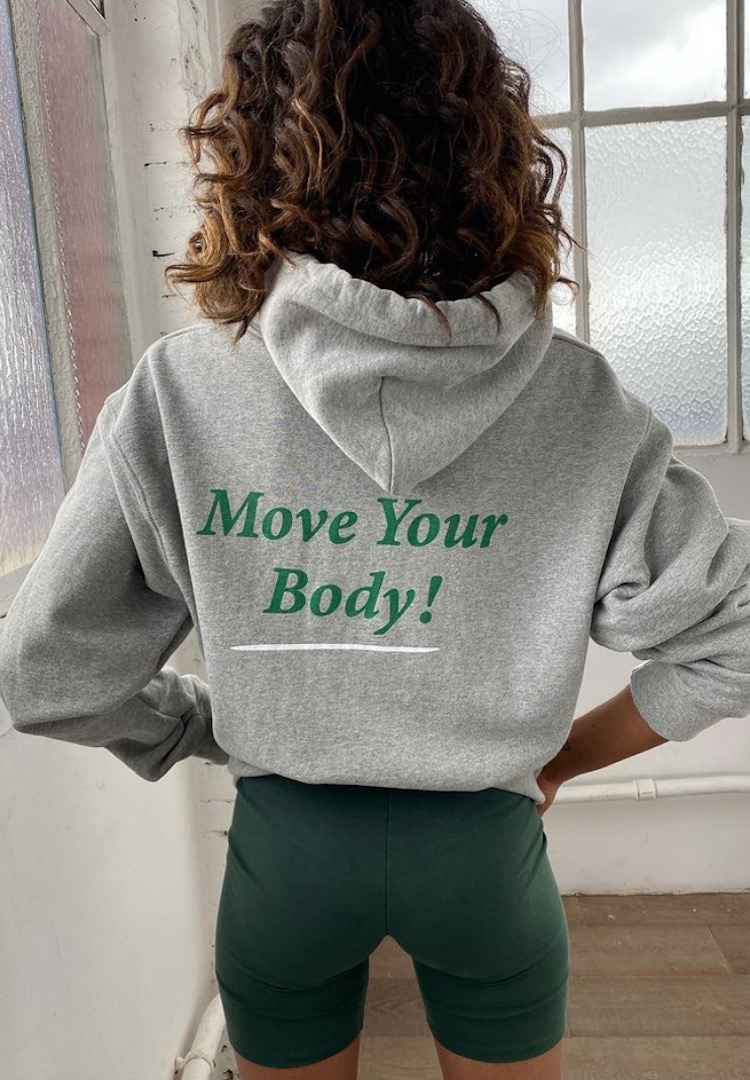How to be online and also be happy: An excerpt from Issy Beech’s new book
WORDS BY ISSY BEECH
An exclusive excerpt on untangling yourself from your smart phone, from How to be Online and Also be Happy.
Accepting that your phone hurts your physical body is the easy part. It’s not hard to imagine, really, between the incessant findings that our bodies are evermore buckling, literally, under the pressure of our screen time. But taking that information and putting it towards new habits tends to feel, for some reason, more or less impossible.
No matter how concise the infographic or shell-shocking the article, we still can’t seem to make holding our phones in both hands and up at eye level feel anything but totally absurd. Consider this your official wake up call to do something about it, once and for all.
We like nosy people. Don’t be shy, head to our Life section for more.
In 2014, Dr Kenneth K Hansraj, Chief of Spine Surgery at New York Spine Surgery and Rehabilitation Medicine, conducted a study that showed when we bow our heads to look at our phones, they become a heavier strain on our necks. The lower we tilt our necks towards our laps, the more weight our necks have to carry. If your head upright weighs five kilos, when tilted forward fifteen degrees it’s more like twelve, which is your head plus three bricks.
When your neck is tilted forty-five degrees downwards, your head might as well weigh twenty-two kilos, or, your head plus two bowling balls. If we’re spending three and a half hours a day on our phones, that’s one full day a week we’re putting a strain on our necks and backs. Almost two months of every year.
The just-about worldwide habit of leaning our heads forward, day in and out, until we sustain permanent injury is what they now call text neck. It causes neck pain, shoulder pain, back pain, headaches. Stiffness, tightness and a more forward-leaning posture.
But text neck – and text back and text thumb – aren’t the only afflictions we’re suffering from thanks to our devices. We’re also experiencing dry eyes (in droves), sore eyes and blurred vision. Nerve damage, muscle damage, disc compression or herniation, headaches, early arthritis, numbness, depression, loss of lung capacity, and likely worse. After all, we’re only fifteen years into having smartphones.
Me? Three years ago, I woke up and couldn’t move. Unable to sit up or even turn my head on the pillow while lying down, I was frozen. Something had gone wrong in my back. I lay there, sort of planking involuntarily for a while, my anxiety mounting.
By 10 am, I had unfrozen enough to text someone, and by 11 am, enough to wriggle loose and free myself like Michelle Pfeiffer in What Lies Beneath. Then into the shower, into some clothes and off to work in an Uber, crumpled up in the backseat like an old receipt.
I felt basically fine until lunch, when my neck seized up again, and so I’d waddled out of work to an appointment. In the office of a myotherapist I’d never met before, I was firmly told, “You have to use your phone way, way less”.
It seemed absurd that I, a spritely-ish twenty-eight year old, a well-enough person, a person with dreams and desires, should end up incapacitated just from having an iPhone and looking at it a huge amount. But I decided to hear him out anyway.
After my appointment, I began to notice little things about how I lived my life. I noticed that I usually held my phone near to my lap or on an angle so that my head was always twisting to meet it. I noticed that it was normal for me to lie in bed with my laptop on my stomach, my chin resting on my chest. I also noticed that it kind of hurt. (Had it always been this way?)
I held my phone too far away from my face, too close up, too tilted, too bright, too dim. I’d crush my phone-holding arm underneath myself on the couch on my side, reading forty-two-part threads on Twitter while I cut off the blood to my hand with my body weight.
I got tiny cramps running between thumb and pinky when I scrolled the apps, and a dent in my palm that the corner of my phone made after a session. A sore shoulder, headaches, sore eyes, and I noticed how long it took me to get to sleep at night.
I started thinking ‘Why did I get this big phone instead of the normal one?’ and ‘Do I always scrunch my shoulders up like this when scrolling?’ And ‘What the hell is wrong with me?’. After a little while of properly paying attention, I also began to notice minute spasms in my lower back which didn’t feel new. I’d probably just never picked up on it before.
Then tingles down the back of my right arm, along my elbow and forearm and into the right side of my hand. Aches in the upper-middle-ish of my back. A kind of tightness in the right side of my neck. Soon, it was impossible to ignore how painfully inconvenient this item was, and yet… here we were. Best friends, inseparable. Madly in love, you might even say.
These aches and pains and mutations were the body’s way of saying, ‘Enough, idiot. You haven’t figured it out on your own yet, so here it is: undeniable proof. This thing needs to go’. I won’t lie to you; I never intended to part ways with my phone over this. But I also wasn’t entirely sure that I’d ever change anything at all, not even the worst habits.
For a few weeks after the appointment, I kept using my phone as I always had. Why? Because it was fun! And everybody else was doing it! Even when my arm tingled or my neck hurt, I wouldn’t do the exercises or even put down the phone.
I thought ‘Maybe it’ll go away by itself’. And I might never have done anything differently at all if not for the shiatsu masseuse I encountered one rainy weekday morning who asked me, nonchalantly, at the beginning of a session, “So when did you break your back?”. I was humiliated enough to finally make some changes.
Very slowly, I forced myself to try habits recommended by doctors, therapists and Instagram gurus alike: holding your phone in both your hands, holding it right up to your face and taking breaks to twirl your neck and arms around at intervals. Stretching, closing my eyes, turning my phone all the way off and charging it in a room far away at night.
These new habits slipped and fell by the wayside all the time, and still do. In fact, there have been times where I’ve caught myself on my phone, in a contorted position on the couch while half-watching the TV and also clenching my teeth, writing a passage for this very book. About the insidious nature of unconscious device use.
But more and more, these habits become a part of me and who I actually am. I choose to do them because I care about myself and am afraid of becoming a giant mollusc. (I sometimes have to remind myself, out loud, of this). And I continue to do them because I now see the relationship between the exercises and a better quality of life.
So, between phone use and computer use, and as often as I can be bothered (which is more and more all the time), I stretch, I move, I adjust for new angles. When I notice that soreness coming around in my palm or a sting in my little finger or an ache in my shoulder, I know it’s time to get up. Put the phone down and close the computer. Move around and try using my body in a different way.
Stretches, exercises and breaks from devices will genuinely make the difference between becoming a pretzel and not becoming a pretzel somewhere down the line (no, I don’t know when). Find ways to build these new habits into your life the way you’d build anything else into it, like waxing, sit-ups, cutting your nails.
Make them part of your daily or weekly routine until they’re no longer an extra step you’re taking, but something you can’t imagine living without. The good news is that stretching and moving will, unlike most things that are good for future you, feel instantly gratifying.
Ways to break out of sleep scrolling
- Move. Do something with your body. Move away from your devices. Hang your head between your ankles or stretch your arms up at the sky. Circle your head around clockwise and anticlockwise. Move whatever limbs you can. Get the blood pumping and let your body feel something.
- Make noise. We can forget how quiet we are while scrolling, searching and gaming, how even our laughing is mostly silent, just barely observable snorts of air. Make some noise for a change! Sing along to music you like, call a friend and talk loudly, or just say stuff to your pet or plants or whatever. And try doing it without turning it into content.
- Use that beautiful brain. Do a quiz or a test, watch an educational YouTube tutorial or a mini-doco. Do something that actually requires your attention, but not much from your hands. You don’t even have to get off your phone or computer, just break up the monotony.
- Listen. Just stop and sit or stand quietly. Close your eyes and pay attention to the sounds and movements around you. Sink into your couch cushion or your patch of grass and take a moment to pay attention to the world moving around you.
- Be real-world social. Go and see another person. Sit across from them and hear them speak. Buy them a coffee. Tell them your thoughts. Ask how they’re feeling. Let the unbridled goodness of IRL human connection get to you.
This is an edited extract from How to be Online & Also be Happy by Issy Beech, published by Hardie Grant Books, RRP $19.99, available in-stores nationally.













